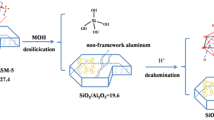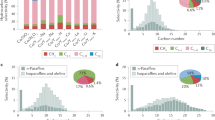Abstract
Crude oil is an important feedstock for the petrochemical industry and the dominant energy source driving the world economy, but known oil reserves will cover demand for no more than 50 years at the current rate of consumption1. This situation calls for more efficient strategies for converting crude oil into fuel and petrochemical products. At present, more than 40% of oil conversion is achieved using catalysts based on faujasite; this zeolite requires extensive post-synthesis treatment to produce an ultrastable form2,3, and has a large cavity accessible through four 0.74-nm-wide windows and thus limits the access of oil molecules to the catalytically active sites. The use of zeolites with better accessibility to their active sites should result in improved catalyst efficiency. To date, two zeolites with effective pore diameters exceeding that of faujasite have been reported4,5, but their one-dimensional pore topology excludes use in oil refining. Similarly, zeolites with large pores and a three-dimensional pore topology have been reported6,7,8, but in all these materials the pore openings are smaller than in faujasite. Here we report the synthesis of ITQ-21, a zeolite with a three-dimensional pore network containing 1.18-nm-wide cavities, each of which is accessible through six circular and 0.74-nm-wide windows. As expected for a zeolite with this structure, ITQ-21 exhibits high catalytic activity and selectivity for valuable products in preliminary oil refining tests.



Similar content being viewed by others
References
Marcilly, C. Evolution of refining and petrochemicals. What is the place of zeolites? Stud. Surf. Sci. Catal. 135, 37–60 (2001)
Biswas, J. & Maxwell, I. E. Recent process-related and catalyst-related developments in fluid catalytic cracking. Appl. Catal. 63, 197–258 (1990)
Martino, G. Catalysis for oil refining and petrochemistry, recent developments and future trends. Stud. Surf. Sci. Catal. A 130, 83–103 (2000)
Freyhardt, C. C., Tsapatsis, M., Lobo, R. F., Balkus, K. J. Jr & Davis, M. E. A high-silica zeolite with a 14-tetrahedral-atom pore opening. Nature 381, 295–298 (1996)
Yoshikawa, M. et al. Synthesis, characterization, and structure solution of CIT-5, a new, high-silica, extra-large-pore molecular sieve. J. Phys. Chem. B 102, 7139–7147 (1998)
Treacy, M. M. J. & Newsam, J. M. Two new three-dimensional twelve-ring zeolite frameworks of which zeolite beta is a disordered intergrowth. Nature 332, 249–251 (1988)
Camblor, M. A. et al. High silica zeolites with three-dimensional systems of large pore channels. Micropor. Mesopor. Mater. 48, 11–22 (2001)
Corma, A., Navarro, M. T., Rey, F., Rius, J. & Valencia, S. Pure polymorph C of zeolite beta synthesized by using framework isomorphous substitution as a structure-directing mechanism. Angew. Chem. Int. Edn Engl. 40, 2277–2280 (2001)
Baerlocher, Ch., Meier, W. M. & Olson, D. H. Atlas of Zeolite Framework Types 5th edn (Elsevier, Amsterdam, 2000)
O'Keeffe, M. & Yaghi, O. M. Germanate zeolites: contrasting the behaviour of germanate and silicate structures built from cubic T8O20 units (T = Ge or Si). Chem. Eur. J. 5, 2796–2801 (1999)
Corma, A., Navarro, M. T., Rey, F. & Valencia, S. Synthesis of pure polymorph C of beta zeolite in a fluoride-free system. Chem. Commun. 16, 1486–1487 (2001)
Corma, A., Diaz-Cabanas, M. J. & Fornes, V. Synthesis, characterization, and catalytic activity of a large-pore tridirectional zeolite, H-ITQ-7. Angew. Chem. Int. Edn Engl. 39, 2346–2349 (2000)
Blasco, T. et al. Preferential location of Ge in the double four-membered ring units of ITQ-7 zeolite. J. Phys. Chem. B 106, 2634–2642 (2002)
Klinowski, J. Nuclear magnetic resonance of zeolites. Prog. Nucl. Magn. Reson. Spectrosc. 16, 237–309 (1984)
Cerqueira, H. S., Mihindou-Koumba, P. C., Magnoux, P. & Guisnet, M. Methylcyclohexane transformation over HFAU, HBEA, and HMFI zeolites: I. Reaction scheme and mechanisms. Ind. Eng. Chem. Res. 40, 1032–1041 (2001)
Corma, A. et al. Methylcyclohexane and meyothylcyclohexene cracking over zeolite Y catalysts. Appl. Catal. 67, 307–324 (1991)
Lacombe, S., Patrigeon, A. & Benazzi, E. n-heptane hydroconversion and methylcyclohexane cracking as model reactions to investigate the pore topology of NU-88 zeolite. Stud. Surf. Sci. Catal. 135, 4272–4279 (2001)
Rius, J. XLENS, a direct methods program based on the modulus sum function: Its application to powder data. Powder Diffr. 14, 267–273 (1999)
Rius, J. Program LSP7. A program for restrained Rietveld refinement (Institut de Ciència de Materials de Barcelona-CSIC, 1999).
Corma, A., Martínez-Triguero, J. & Martínez, C. The use of ITQ-7 as a FCC zeolitic additive. J. Catal. 197, 151–159 (2001)
Corma, A. & Martínez-Triguero, J. The use of MCM-22 as a cracking zeolitic additive for FCC. J. Catal. 165, 102–120 (1997)
Acknowledgements
We thank J. L. Jordá for partial analyses for the structure determination and for discussions. J.R. thanks the “D. Gral de Investigación” of the MCYT for support. This work was supported by the CICYT.
Author information
Authors and Affiliations
Corresponding author
Ethics declarations
Competing interests
The authors declare that they have no competing financial interests.
Supplementary information
Rights and permissions
About this article
Cite this article
Corma, A., Díaz-Cabañas, M., Martínez-Triguero, J. et al. A large-cavity zeolite with wide pore windows and potential as an oil refining catalyst. Nature 418, 514–517 (2002). https://doi.org/10.1038/nature00924
Received:
Accepted:
Issue Date:
DOI: https://doi.org/10.1038/nature00924
- Springer Nature Limited
This article is cited by
-
N-Doped TiO2–Carbon Composites Derived from NH2-MIL-125(Ti) for Electrochemical Determination of tert-Butylhydroquinone
Food Analytical Methods (2022)
-
Time-resolved in situ visualization of the structural response of zeolites during catalysis
Nature Communications (2020)
-
Study on sulfur-tolerant benzene hydrogenation catalyst based on Pt-encapsulated sodalite zeolite
Reaction Kinetics, Mechanisms and Catalysis (2018)
-
One-pot synthesis of Ni-SSZ-13 zeolite using a nickel-amine complex as an efficient organic template
Journal of Materials Science (2017)
-
Synthesis of SAPO-56 with controlled crystal size
Journal of Nanoparticle Research (2017)





